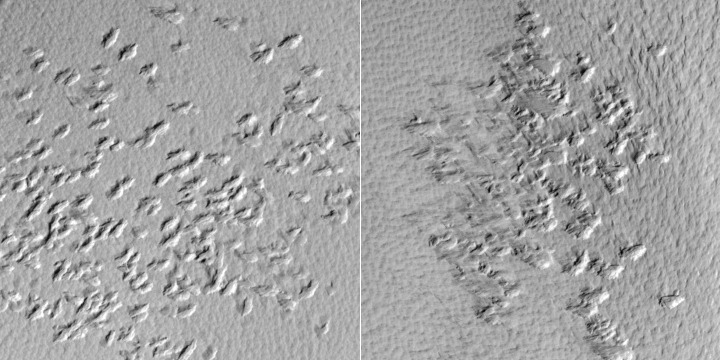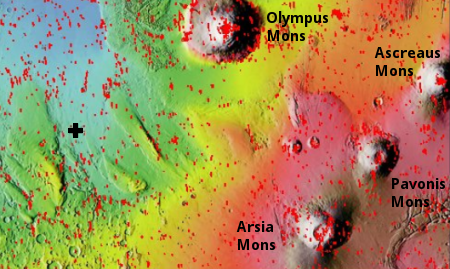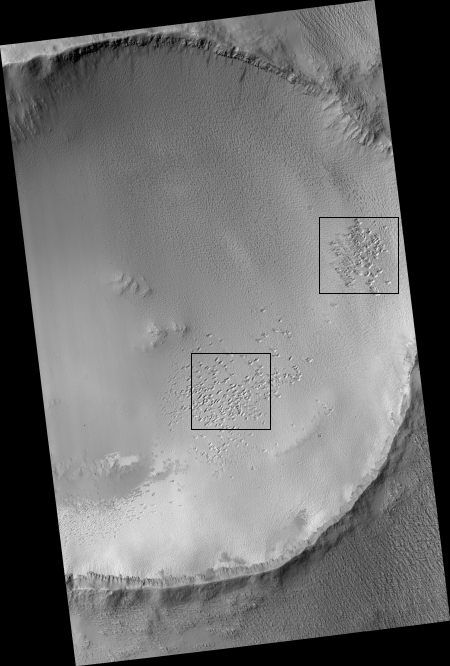A spray of volcanic ejecta on Mars?
Time for some more weird Mars geology! Today the science team for the high resolution camera on Mars Reconnaissance Orbiter released its monthly batch of new images. There is a lot of interesting stuff buried therein, some of which I will feature periodically in the next month.
The image on the right, reduced in resolution to post here, is a good example. (If you click on the image you can see the full resolution version.) It shows a scattering of pits in three specific areas on the crater floor, all in a line going from the northeast to the southwest. Yet, the rest of the crater floor lacks similar pits, and is either very smooth or has a mottled appearance. Both the smooth and the mottled areas appear to have a very faint trend going from the northwest to the southeast, which to my eye appears caused by the general wind direction that flows across the crater floor.
Even more intriguing, the pits in these three areas appear to be mostly oblong and also trend from the northeast to the southwest, cutting across the general trend of the rest of the crater floor. You can see this in the cropped closeups from the full resolution image below, showing the two boxed areas indicated on the image on the right.

The immediate and obvious geological questions are these: Why are the pits only in these three areas? Why do they show a specific trend? And why is it different from the general trend of the rest of the floor?
The pits could be collapse features, produced when the surface subsides into voids below. This can happen in a crater if it has cracks and voids leftover right after impact, which later get covered by Martian dust. At some point the dust could settle, creating the pits.
I am not enamored by this theory. The northeast to southeast trend of the pits doesn’t really fit with this theory. Leftover voids from the initial impact would formed in a more random pattern on the crater floor.
Maybe the pits indicate a larger underground feature that cuts across the crater’s southern regions. A wider shot showing the crater’s eastern rim, taken by Mars Odyssey, suggests this is possible. The crater rim appears distorted directly to the northeast, in line with the pitted areas.

I have another theory, which is more spectacular and thus more entertaining. The overview map on the right shows the location of this crater in relation to Mars’s four giant volcanoes. As you can see, the largest volcano, Olympic Mons, is to the northeast, and actually lines up perfectly with the line of pitted areas on the crater floor. Could there have been an explosive spray of volcanic material from Olympus Mons that spewed molten rocks across the floor of this crater, thus creating the pits?
I like this theory, mostly because it appeals to the dramatic portion of my creative mind. Imagine the size of the explosion that would have flung these rocks this far!
I also suspect it is wrong. More likely, the slow rise of Olympus Mons caused widespread radiating cracks in the surrounding terrain, like the spokes of light radiating out from the twinkle of a star. One of these cracks was below this crater, and as the volcano’s rise caused the crack to widen, the dust settled into it, producing the pits.
All of my speculations here should be treated with great skepticism. I am no geologist. Nonetheless, it is by thinking about these issues that people become geologists. The key is digging into what is known about Mars and applying those facts to come up with a reasonable theory. I have simply not dug very far in these speculations.
On Christmas Eve 1968 three Americans became the first humans to visit another world. What they did to celebrate was unexpected and profound, and will be remembered throughout all human history. Genesis: the Story of Apollo 8, Robert Zimmerman's classic history of humanity's first journey to another world, tells that story, and it is now available as both an ebook and an audiobook, both with a foreword by Valerie Anders and a new introduction by Robert Zimmerman.
The print edition can be purchased at Amazon or from any other book seller. If you want an autographed copy the price is $60 for the hardback and $45 for the paperback, plus $8 shipping for each. Go here for purchasing details. The ebook is available everywhere for $5.99 (before discount) at amazon, or direct from my ebook publisher, ebookit. If you buy it from ebookit you don't support the big tech companies and the author gets a bigger cut much sooner.
The audiobook is also available at all these vendors, and is also free with a 30-day trial membership to Audible.
"Not simply about one mission, [Genesis] is also the history of America's quest for the moon... Zimmerman has done a masterful job of tying disparate events together into a solid account of one of America's greatest human triumphs."--San Antonio Express-News


